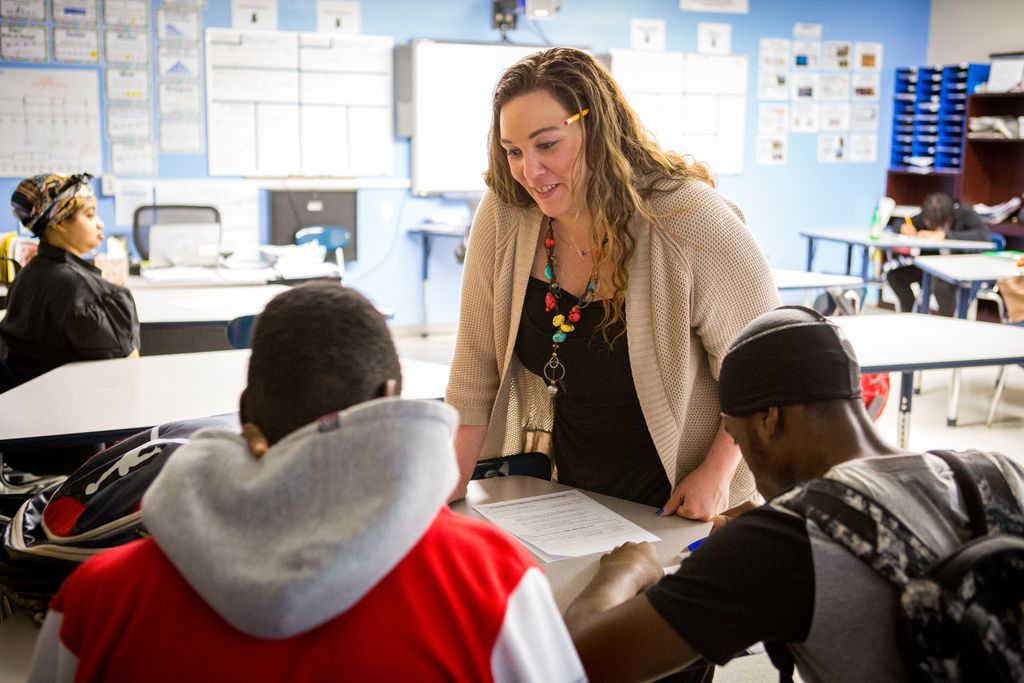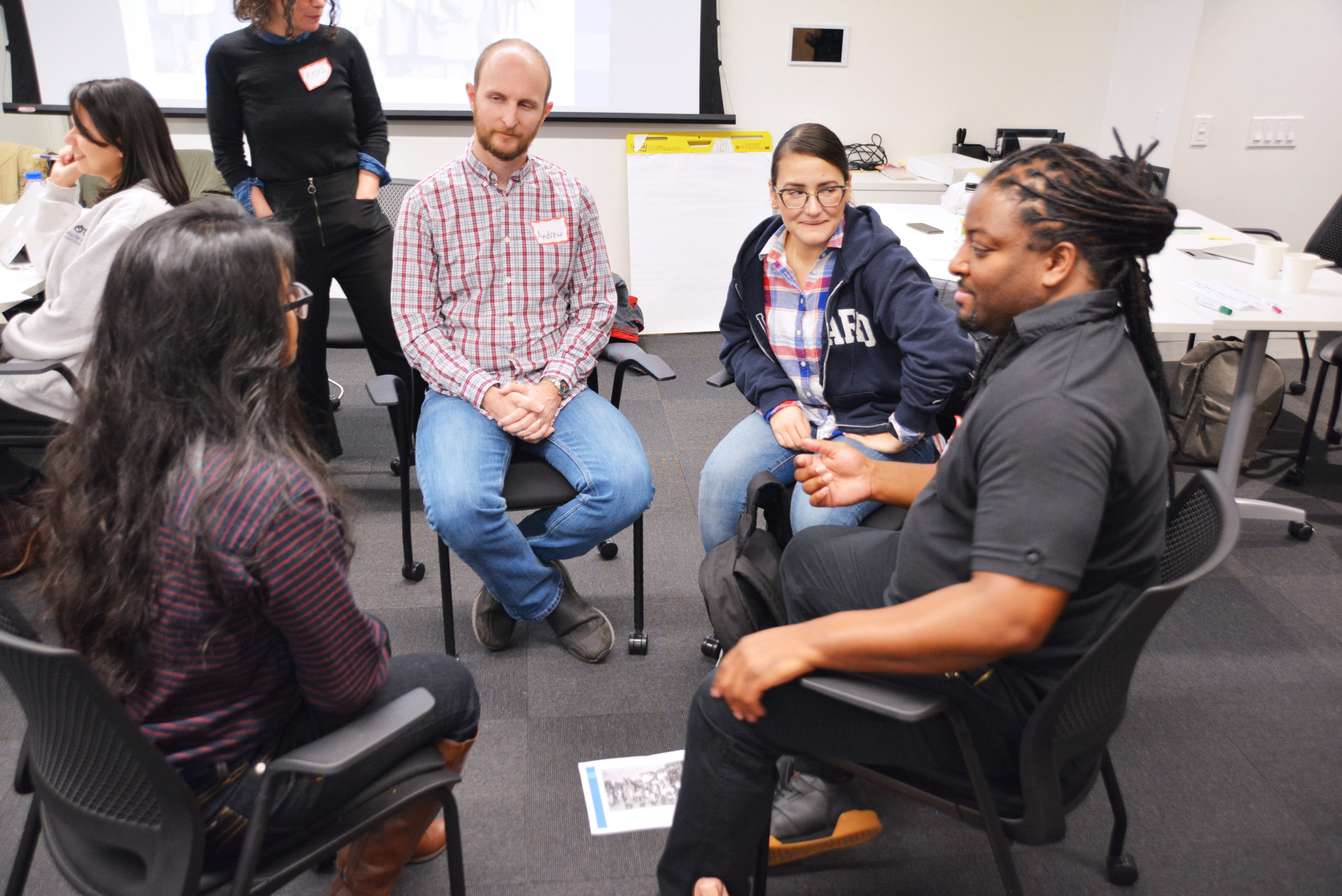Instructional Network for School Improvement
We are working towards 100% College Readiness in Algebra I by the end of 9th grade. We are focused on addressing disproportionate outcomes among Black and Latino students and students experiencing poverty.
About the Instructional Network for School Improvement
The Instructional Network for School Improvement (INSI) brings twenty-three New York City schools together to use common tools and common methods to meet a shared aim of increasing the number of Black students, Latino students, and students experiencing poverty who graduate from high school and enroll in a postsecondary opportunity that allows them to succeed in life.
The initiative, funded by the Bill & Melinda Gates Foundation, builds on the continuous improvement work of the New Visions College Readiness Network for School Improvement (CRNSI) with a focus on shared math curriculum for ninth grade, using the Illustrative Mathematics Algebra I course.
Our Network Aim

Our vision is that 100% of students complete ninth grade college ready in mathematics.
By 2025, our network’s aim is for all schools to have a college-ready Algebra 1 rate at or above 72% across all subgroups.
Our school teams work together as a community of practice to connect, share, and make sense of change ideas that will increase the impact of each school’s teaming, Illustrative Mathematics implementation, student belonging improvements, and student learning improvements.
These approaches are directed towards changing key practices in schools that will manifest in measureably improved outcomes along five primary drivers.
Our Drivers and Key Practices
-
Drivers
We believe improvement along these five drivers will support our students meeting the network aim.
- School master program prioritizes needs for Algebra 1.
- Students are in attendance consistently.
- Students feel belonging in math class and in school.
- Students engage in a problem-based math curriculum.
- Students engage in additional supports for topics that require it.
-
Key Practices
We believe changing these key practices will lead to improvement along our drivers.
- Attendance:
- Identify chronically absent students based on middle school data (summer and start of year)
- Identify a group of chronically absent students.
- 1:1 weekly check-ins with chronically absent students.
- Set goals and plan around academic calendar with chronically absent students.
- Peer group support.
- Belonging:
- Build a mathematical classroom community plan.
- Carry out 1:1 and small group check-ins with students.
- Set goals and reflect with students.
- Write student accessible lesson objectives.
- Additional Supports:
- Identify students requiring additional support.
- Use informal, unit and interim assessment data to identify additional support needs.
- Utilizing a standalone intervention course.
- Utilizing IM Algebra I supports.
- Utilize in-class Tier 2 interventions.
- Implementing intervention curriculum 3-5x a week.
- Attendance:
Our Approaches
-

Illustrative Mathematics Implementation
A compelling research base supports the use of shared curriculum in schools and districts, demonstrating stronger student outcomes and clearer avenues for teacher collaboration. INSI began by adopting Illustrative Mathematics as the shared Algebra I curriculum in our participating schools; we are now part of the citywide implementation of IM in NYC Public Schools.
School teams set aside time for their own reflective analysis of the team’s implementation of Illustrative Mathematics that supports the next cycle of improved enactment. While the content and format of this reflective “Study – Act” work will be developed by the school team with an INSI coach’s support, each team does the work within shared windows of time so that implementation lessons can be shared across the network.
-

Building Student Belonging
Focusing on 9th grade as a disciplined multi-year improvement effort to ensure students remain in high school and graduate on time. Using data and analysis provided by the PERTS Elevate survey, we are working to improve classroom conditions directly supporting a sense of belonging and a capacity for achievement.
The iterative work to improve students’ perceptions of belonging are recorded to share with other schools in the network, particularly those change ideas that had the desired effect of improving students’ perceptions of belonging.
-

Increasing Student Learning in Mathematics
Proficiency in Algebra 1 unlocks for students the opportunity to join higher level math courses and supports them in opting out of remedial pre- and co-requisites after high school. When INSI started, 39% of ninth-grade students in participating schools achieved a college-ready designation; we have recovered from a dip in COVID and aim to double that percentage by June 2025.
School teams set aside time to analyze interim data measuring student achievement. Based on that analysis, teams identify how to continuously improve students’ mathematical learning, how to address knowledge and skill gaps using Illustrative Mathematics curriculum, and how to track individual and aggregate growth approaching the next assessment window.
Data tools used include both Mock Regents and the Portal by New Visions.
-

Developing School Team Capacity
Each of our 23 participating schools creates and sustains a continuous improvement team that addresses student belonging and student learning in mathematics, either separately or in a combined approach.
School-level teams ensure the learnings from the network take hold and have a positive impact at each school. The continuous improvement work at the heart of INSI depends upon teams with at protected and regular meeting times. INSI coaches provide support for team building and the CI work in teams.
- Each school has one team focused on the continuous improvement of students’ math achievement, including both the implementation of Illustrative Mathematics curriculum and the measurement of and response to student learning outcomes
- Each school also does additional continuous improvement work on student belonging, specifically in the mathematics classroom and/or generally in the school
- This may be a separate second team, or
- This may be included in the work of the math achievement team
-

Network Learning
Network Convenings
We learn as a network by coming together up to three times a year to share and learn from our work, celebrate successes, and connect socially. We expect that each school team participating in INSI will fully participate in all network convenings. The New Visions team ensures that convenings are inspiring, relevant, and well-timed, to maximize impact on schools’ work.
Team and Data Lead Community of Practice Conveneings
Each school’s team and data leads meet in monthly convenings to share developing practices, to build capacity to analyze aggregate and individual data, and to increase our understanding of continuous improvement in networked communities.
Our Hub Team
-

Eric Giraldo-Gordon
Instructional Continuous Improvement Coach (ICIC)
-

Jennifer Kim
Instructional Continuous Improvement Coach (ICIC)
-

Wendy Thomas-Williams
Instructional Continuous Improvement Coach (ICIC)
-

Kiran Purohit
Vice President, Curriculum and Instruction
-

Russell West Jr.
Director of Curriculum & Instruction
-

Danielle Hayden
Program Evaluation Specialist, Curriculum and Instruction
-

Susan Rosello
Program Coordinator, Curriculum and Instruction